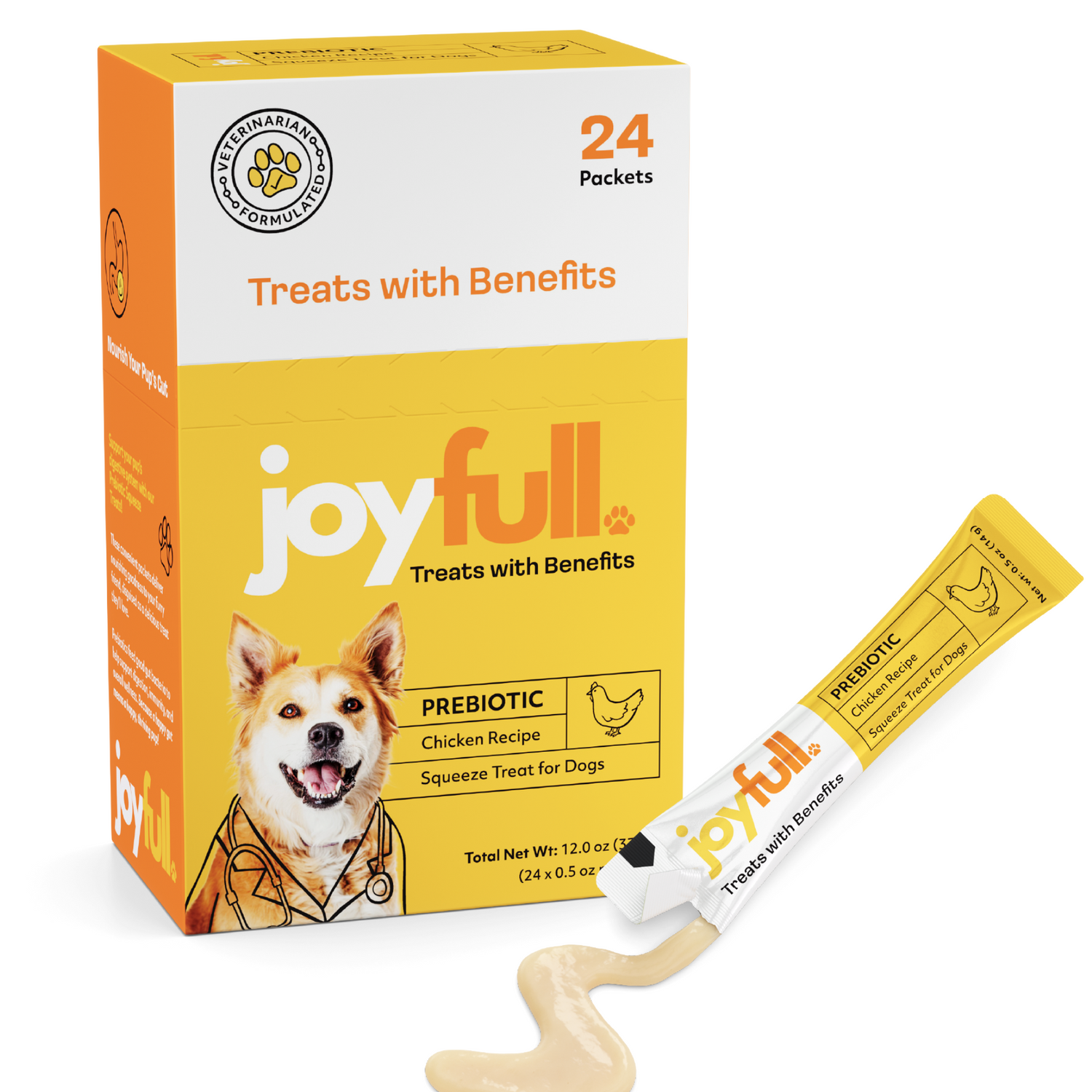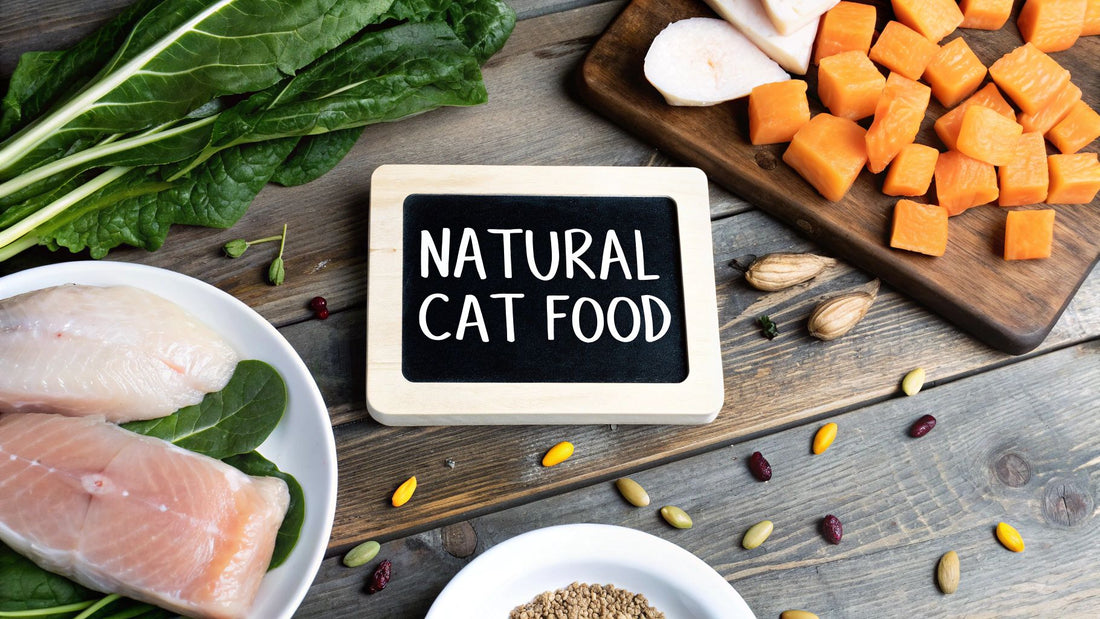
Finding the Best Natural Cat Food Brands
When you start looking for the best natural cat food brands, you’re really looking for recipes built on whole, recognizable ingredients. It’s about cutting through the noise and finding food that skips the artificial preservatives, colors, and flavors. Brands like Orijen, Wellness CORE, and Blue Buffalo Wilderness have built their reputations on prioritizing high-quality animal proteins and creating nutrient-dense formulas.
This guide will walk you through what "natural" actually means in the pet food world and help you pick the best possible option for your cat.
Decoding Natural Cat Food Labels
Stepping into the pet food aisle can feel overwhelming. Every bag seems to scream "natural," but what does that label truly promise? The secret is learning to separate genuine, high-quality food from clever marketing by understanding the official definition.
Think of the word "natural" as a starting point. The Association of American Feed Control Officials (AAFCO) has guidelines stating that for a food to be labeled "natural," its ingredients must come from plant, animal, or mined sources. More importantly, they can't be produced or broken down using chemically synthetic processes. This immediately rules out artificial flavors, colors, and chemical preservatives.
What to Look for on the Label
In essence, that "natural" label acts as a filter, automatically weeding out many of the unnecessary additives you'll find in standard cat foods. It helps you zero in on the stuff that actually fuels your cat's health.
Here’s what you should be scanning for on the ingredient list:
- Whole Protein Sources: You want to see specific animal proteins like "deboned chicken," "salmon," or "turkey" right at the top. Vague descriptions like "meat by-products" are a red flag and generally point to lower-quality sources.
- No Artificial Additives: A genuinely natural food won’t contain chemical preservatives like BHA, BHT, and ethoxyquin. It also won't have any artificial colors or flavors, which serve no nutritional purpose and are only there to make the food look more appealing to humans.
- Minimal Processing: All dry kibble has to be cooked, but natural brands often use gentler cooking methods. This helps preserve the vitamins, minerals, and amino acids in the original ingredients, ensuring more of that goodness makes it into your cat's bowl.
This push for cleaner ingredients isn't just a trend; it’s a fundamental shift in how we think about pet wellness. Owners are realizing that what goes into their cat's food has a direct impact on their health.
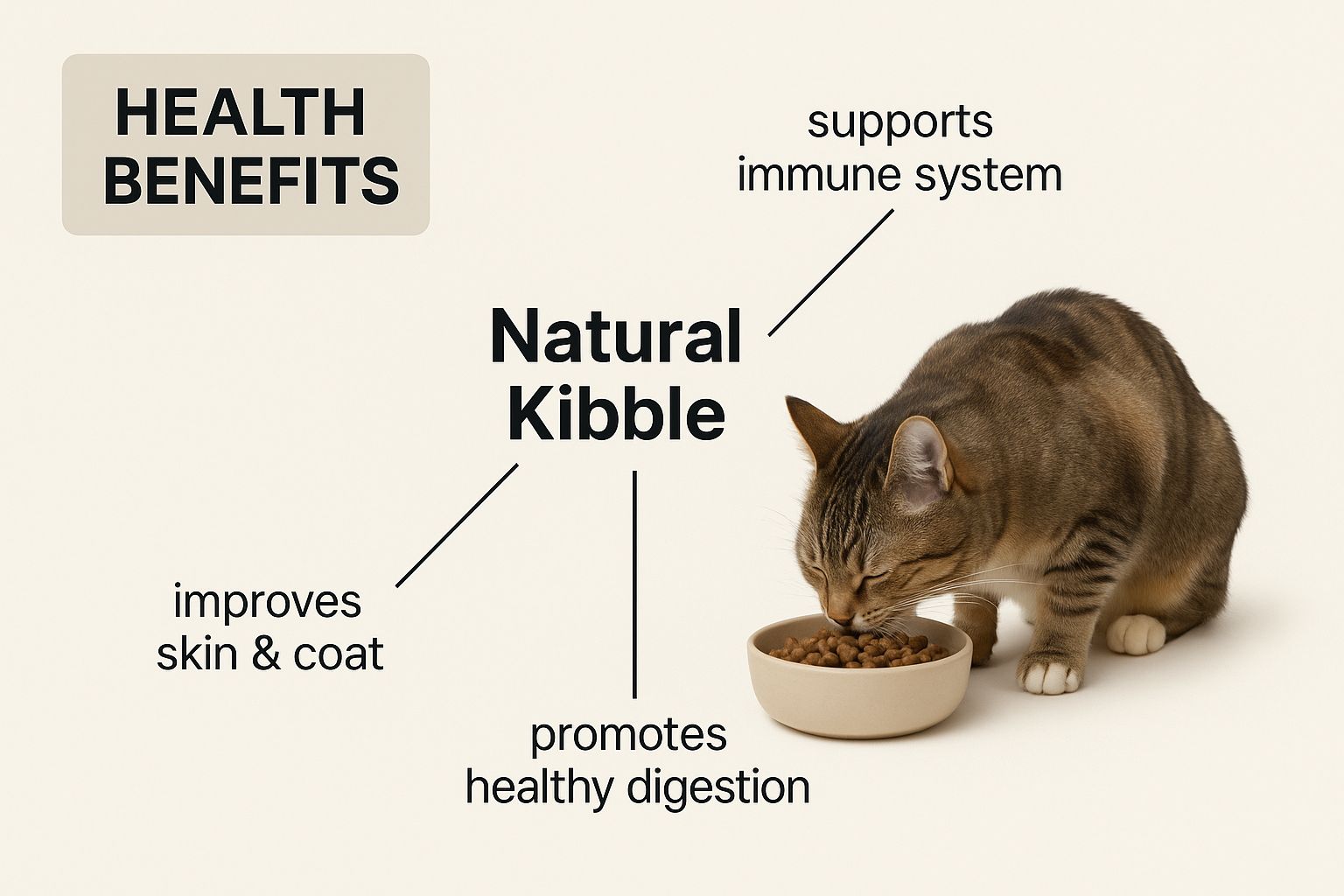
As the image shows, a diet packed with high-quality protein and free from artificial junk is the foundation for a vibrant, healthy cat. Once you get these basics down, you’re in a much better position to make a smart choice. For a deeper dive, check out our guide on how to choose the right cat food tailored to your cat's unique needs.
To help visualize the difference, here’s a quick comparison of what you'll typically find in natural versus conventional cat foods.
Natural vs Conventional Cat Food at a Glance
| Feature | Natural Cat Food | Conventional Cat Food |
|---|---|---|
| Primary Protein | Named whole meats (e.g., chicken, salmon) | Often uses by-products or vague "meat meal" |
| Preservatives | Natural sources like tocopherols (Vitamin E) | May use chemical preservatives (BHA, BHT) |
| Colors & Flavors | None artificial; flavor from real ingredients | Often contains artificial colors and flavors |
| Carbohydrates | Whole sources like sweet potatoes, peas | Often relies on fillers like corn, wheat, soy |
| Ingredient Sourcing | Tends to prioritize transparency and quality | Sourcing can be less transparent and varied |
This table makes it clear that the "natural" label is more than just marketing—it signifies a real difference in ingredient philosophy and quality.
The demand for these cleaner, more transparent options is fundamentally changing the pet food industry. The global pet food market, valued at roughly USD 128.21 billion in 2025, is expected to surge to USD 185.54 billion by 2030. This growth is almost entirely fueled by pet owners like you demanding healthier products.
What to Look For in a Quality Natural Diet
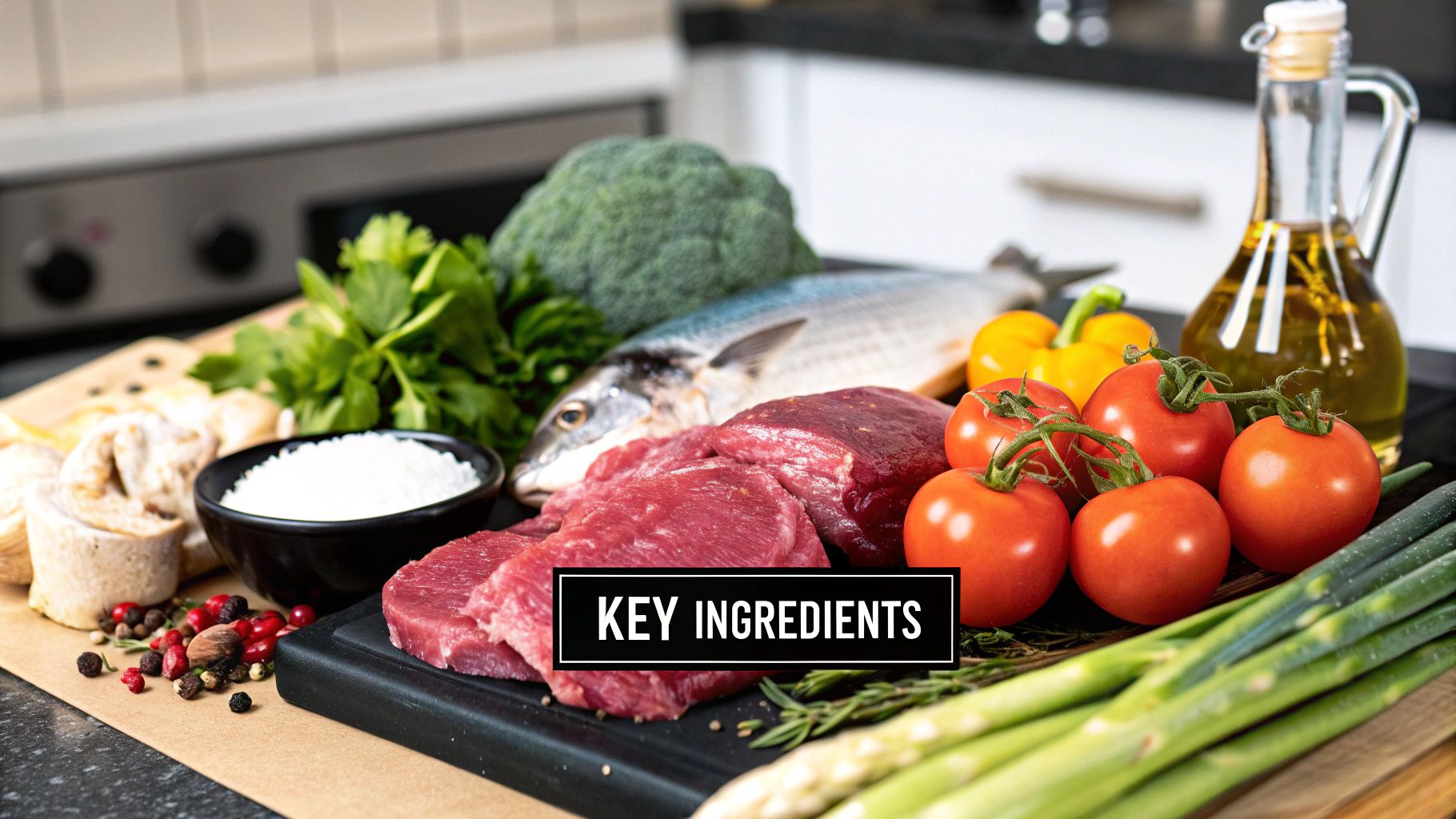
Okay, so you know how to read a cat food label. But what exactly are you looking for? This is where you get to put on your pet nutritionist hat and make a real difference for your cat.
It all comes down to one simple, biological fact: cats are obligate carnivores. That’s just a scientific way of saying their bodies are designed to run on animal-based nutrients. Forget what works for humans or dogs—your cat’s needs are unique. This single idea should be your North Star when you're comparing bags and cans.
Think of it like building the perfect meal for a tiny, furry athlete. The main event isn't grains or veggies; it's high-quality, recognizable animal protein. That’s the non-negotiable foundation of their diet.
It's All About High-Quality Protein
When you turn that bag around and scan the ingredient list, the very first things you see should be named sources of animal protein. If the language is vague, it's an immediate red flag.
Here's a quick cheat sheet for what you want to see versus what should make you pause:
- The Best Stuff: "Deboned chicken," "salmon," "turkey," or "duck." These are specific, whole-food ingredients that provide protein your cat can easily digest and use.
- Also Good: "Chicken meal" or "turkey meal." Don't let the word "meal" scare you. It’s simply a concentrated protein where water and fat have been removed, making it a very nutrient-dense ingredient.
- Proceed with Caution: "Meat by-products" or "poultry by-products." These are mystery terms. They refer to what's left of an animal after the main cuts are gone. While not inherently toxic, the quality is inconsistent and far less desirable than a named meat.
Knowing what to look for is only half the battle. Knowing what not to include is just as important. To get a complete picture, make sure you're familiar with the common cat food ingredients to avoid to keep your cat safe from unnecessary fillers and additives.
Fats and Carbs: The Supporting Cast
After protein, healthy fats are the next essential component. They're a major source of energy and are vital for absorbing certain vitamins. Look for clearly named sources like chicken fat or salmon oil. These provide crucial omega-3 and omega-6 fatty acids, which are fantastic for keeping your cat's skin supple, their coat shiny, and their joints healthy.
What about carbs? Cats have very little biological need for them, but small amounts of the right kind can be beneficial for fiber and extra nutrients. The key is quality over quantity.
- Good Carbs: Think sweet potatoes, peas, and carrots.
- Problematic Fillers: Corn, wheat, and soy are common cheap fillers. They offer minimal nutritional value and are frequent culprits behind food sensitivities and allergies.
The ideal food is one where protein is the star of the show, backed up by healthy fats and just a handful of high-quality, digestible carbs. This formula is the closest you can get to what a cat would eat in the wild.
Don't Forget the Micronutrients
Finally, a truly complete natural cat food will be fortified with essential supplements to cover all the bases. The most critical one is Taurine. This amino acid is absolutely essential for a cat's heart function and vision. Since some of it can be lost during the cooking process, you should always see it added back into the formula.
Look for other power-packed extras, too. Antioxidants from real fruits and veggies, probiotics to support a healthy gut, and a balanced blend of vitamins and minerals all work together to boost your cat's immune system and keep them thriving for years to come.
The Payoff: What You'll Actually See in Your Cat
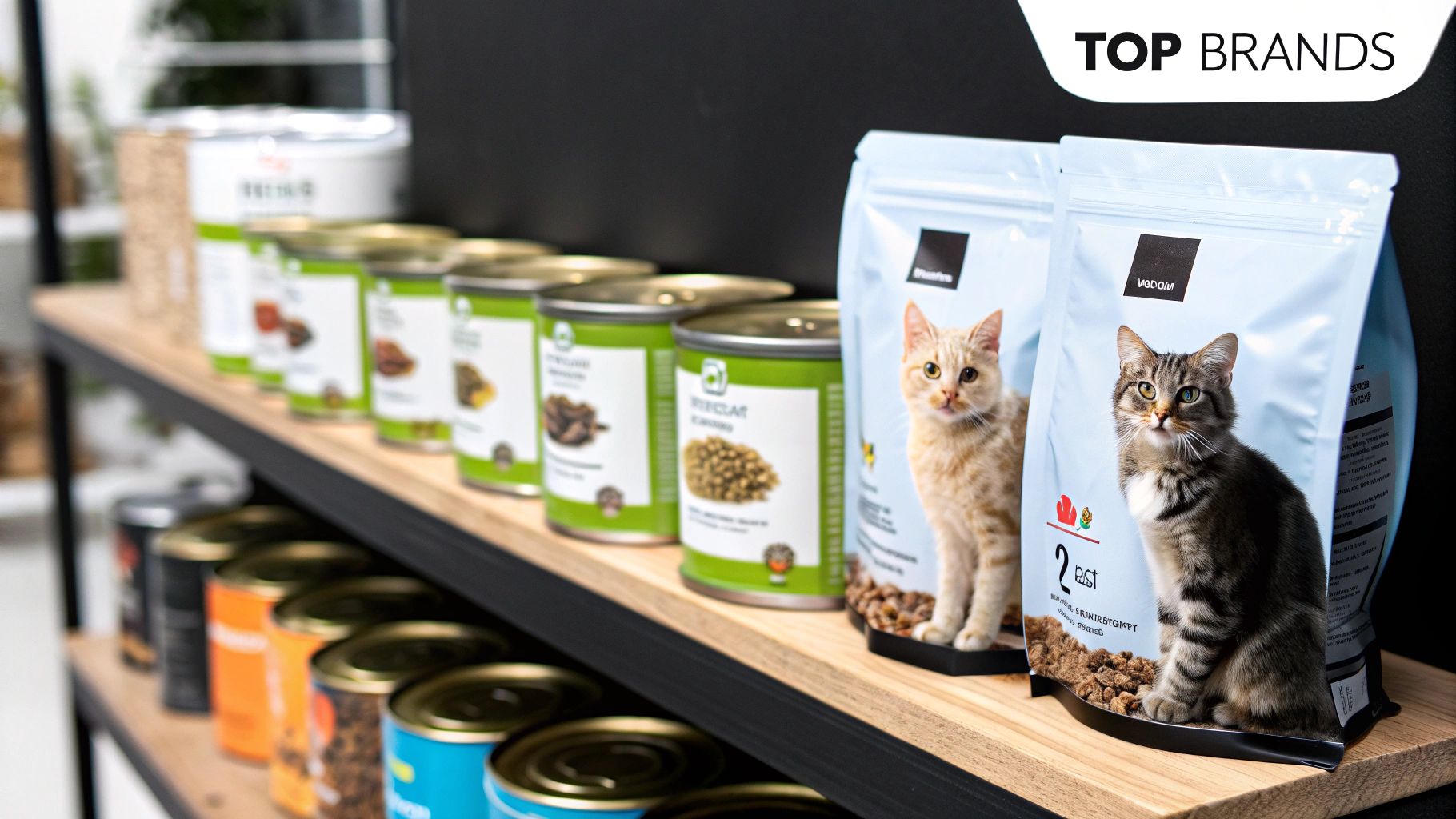
It’s one thing to read an ingredient label, but it’s another thing entirely to see the difference a natural diet makes in your own cat. When you switch from foods loaded with fillers to recipes packed with nutrient-dense, whole ingredients, the results can be surprisingly fast and obvious.
Think of it like swapping out a diet of fast food for clean, whole foods. The body just performs better.
One of the first things you'll likely notice is a major upgrade to their coat. High-quality fats like omega-3 and omega-6 fatty acids, often from fish oil, go straight to work nourishing the skin and hair follicles. Before you know it, that dull fur becomes softer and glossier, and you might even see less shedding and flaky skin.
Better Guts and More Get-Up-and-Go
Cats are carnivores, plain and simple. Their digestive systems are built to process animal protein, not the cheap corn, wheat, and soy fillers that bulk up so many commercial pet foods. Removing those hard-to-digest carbs can completely change their digestive health for the better.
This often translates to real, tangible changes:
- Smaller, less stinky litter box trips: When their bodies absorb more nutrients from the food, there’s simply less waste coming out the other end.
- A calmer tummy: You may see a dramatic reduction in random vomiting or diarrhea that often stems from food sensitivities.
- More consistent energy: Without the blood sugar rollercoaster caused by cheap carbs, your cat’s energy becomes steady. An older cat might even start acting more like a playful kitten again.
When their bodies aren't working overtime to process junk ingredients, that energy gets freed up for more important things—like chasing toys and climbing their cat tree. It’s a boost in vitality you can genuinely see.
A natural diet works from the inside out. By providing the biologically appropriate fuel your cat was designed to eat, you're not just feeding them—you're supporting their entire system for long-term health and wellness.
Better nutrition is also a cornerstone of healthy weight management. Protein-rich, low-carb food helps cats feel full and satisfied, which is a game-changer for preventing the overeating that leads to obesity. For a cat that's already overweight, switching to one of the better natural cat food brands can be a critical step in helping them slim down while keeping their essential muscle mass.
Of course, even the healthiest diet can't prevent every accident. That's why being prepared is so important. Knowing what to do in an emergency by taking a pet first aid class gives you an invaluable layer of security and peace of mind.
A Closer Look at Top Natural Cat Food Brands
Walking down the cat food aisle can be overwhelming. So many bags, so many claims. But once you know what to look for, the best brands start to stand out from the crowd. The goal is to find a brand whose philosophy and ingredients line up with what your cat truly needs, whether you have a tiny kitten or a seasoned senior.
And you're not alone in looking for better options. The demand for high-quality, natural cat food has exploded. The US cat food market was already worth a staggering USD 38.42 billion in 2022 and is expected to hit USD 55.64 billion by 2032. This isn't just a fad; it’s a movement driven by owners who want the absolute best for their pets. You can dig deeper into these numbers by exploring the US cat food market insights.
So, let's cut through the noise and look at a few of the top players that consistently deliver on their promises.
Blue Buffalo Wilderness High Protein Natural Adult Dry Cat Food
You've probably seen Blue Buffalo around. They've built their reputation on the idea of feeding pets like their wild ancestors. Their Wilderness line is the perfect example of this in action, focusing on a high-protein, low-carb diet that cats are biologically designed to eat.
- Primary Proteins: They lead with the good stuff: real, deboned chicken, turkey, or salmon.
- Key Philosophy: This entire line is grain-free, making it a go-to for cats that have trouble with grains.
- Ideal For: Energetic adult cats who need plenty of quality protein to maintain their lean muscle.
What’s unique to Blue Buffalo is their LifeSource Bits. These are little dark kibbles mixed in with the rest, packed with a special blend of antioxidants, vitamins, and minerals chosen by vets to support a healthy immune system.
Wellness CORE Grain-Free Natural Cat Food
Wellness CORE runs with a similar protein-first mindset but really doubles down on nutrient density. Think of their philosophy as "all killer, no filler." Every ingredient has a purpose, and their formulas are crafted to deliver a serious nutritional wallop in every meal.
This approach makes their food a great choice for managing your cat's weight. The high protein helps them feel full and satisfied for longer, which can naturally curb overeating. They also have a ton of variety, from classic pâtés to chunky morsels and, of course, dry kibble.
Pro Tip: When you’re comparing brands like Wellness CORE and Blue Buffalo, pay close attention to the type of protein. If you know your cat gets an upset stomach from chicken, look for a brand that offers other options, like duck or rabbit.
Orijen Cat & Kitten High-Protein Dry Cat Food
Orijen takes the "ancestral diet" concept to another level with its "whole prey" philosophy. This is a game-changer. Instead of just using muscle meat, their recipes include organ meats and cartilage. This provides a complete nutritional profile that’s incredibly close to what a cat would eat in the wild.
- Primary Proteins: The ingredient list is seriously impressive, often featuring free-run chicken and turkey, wild-caught fish, and nest-laid eggs.
- Key Philosophy: Their focus is on "biologically appropriate" nutrition, using a wide variety of fresh, regional animal ingredients.
- Ideal For: Anyone looking for a top-of-the-line, nutrient-packed food for cats at any stage of life.
The quality here is undeniable, but it does come with a premium price tag. For those also considering certified organic options, our guide to the best organic cat food is a great next step.
Instinct Original Grain-Free Recipe Natural Cat Food
Instinct has carved out a special place for itself as the leader in raw-inspired nutrition. Their core belief is that raw is the absolute best thing for our pets, and they've found a clever way to make it more practical for everyone.
Their secret? The kibble is tumble-coated in crushed, freeze-dried raw meat. This simple step adds a powerful boost of pure nutrients and a rich, meaty flavor that drives picky eaters wild. If you're intrigued by the benefits of a raw diet but aren't quite ready to commit, Instinct is the perfect bridge.
To help you see how these brands stack up at a glance, we've put together a simple comparison table.
Comparing Leading Natural Cat Food Brands
This table breaks down the key features of the brands we've discussed, making it easier to see how their philosophies and offerings differ.
| Brand Name | Primary Protein Sources | Specialty Formulas | Price Point |
|---|---|---|---|
| Blue Buffalo Wilderness | Deboned Chicken, Salmon, Turkey | High-Protein, Grain-Free | Mid-Range |
| Wellness CORE | Chicken, Turkey, Salmon, Herring | Nutrient-Dense, Weight Management | Mid-to-High |
| Orijen | Chicken, Turkey, a variety of Fish, Eggs | "Whole Prey" philosophy, Biologically Appropriate | Premium |
| Instinct Original | Chicken, Salmon, Rabbit | Raw-Coated Kibble, Good for Picky Eaters | Mid-to-High |
Ultimately, each of these brands offers a fantastic, high-quality product. The "best" one really comes down to what fits your cat's specific health needs, your personal philosophy on pet nutrition, and your budget.
How to Switch Your Cat to a New Food
So you've found the perfect natural food for your cat—that's fantastic! But the job isn't quite done. The next step is a big one: actually getting your cat to eat it without staging a protest or, worse, getting an upset stomach.
Cats are creatures of habit, and their digestive systems are sensitive. An abrupt food change is often a one-way ticket to trouble. The secret to success is patience and a slow, gradual introduction. Think of it less like a switch and more like a gentle fade-in. This gives their gut bacteria time to adjust, which is key to avoiding digestive upset.
The Seven-Day Switch: A Simple Schedule
The "go slow" method is the best way to change your cat's diet, hands down. A seven-day plan is usually just right for getting them used to the new flavors and textures. It's a simple process that dramatically reduces the risk of tummy troubles and helps even the fussiest eaters come around.
Here’s a day-by-day plan that works like a charm:
- Days 1-2: Start with a mix of 75% old food and just 25% new food. This is just a little sneak peek, letting them get a hint of the new stuff without being overwhelmed.
- Days 3-4: Move to an even 50/50 split of old and new food. At this point, your cat should be getting more familiar with the new food's presence in their bowl.
- Days 5-6: Now you can tip the balance. Serve a meal that's 75% new food and only 25% old food. This is the home stretch.
- Day 7: You did it! It’s time to serve 100% of their new, healthy food.
What to Do if You Hit a Snag
What if your cat just sniffs the new concoction and walks away? First off, don't panic. Picky cats are a reality of life, but a little bit of strategy can make all the difference.
If they refuse to eat, just take a step back. Revert to the previous ratio (the one they did eat) for another day or two before you try moving forward again. Your best tool here is patience.
For the truly stubborn holdouts, try making the new food more enticing. A sprinkle of freeze-dried chicken or a tiny bit of juice from a can of tuna (the kind packed in water!) can make the meal suddenly seem irresistible.
It's also pretty normal to see slightly softer stools during the transition. But if the problem doesn't go away or gets worse, just slow the whole process down. A successful, stress-free switch is the goal, ensuring your cat gets all the goodness from the best natural cat food brands without any of the drama.
Answering Your Questions About Natural Cat Food
Switching your cat to a natural food is a great move, but it almost always brings up a few questions. Even when you know the benefits, it's totally normal to wonder about the practical side of things—like cost, convenience, and what your specific cat really needs.
Let's clear up some of the most common concerns so you can feel good about your decision.
Is Grain-Free Always the Best Option?
Not always, and this is probably one of the biggest myths out there. While a great grain-free food is a fantastic choice for most cats, the real problem has never been all grains. The ingredients to watch out for are the low-quality, high-carb fillers—things like corn, wheat, and soy that offer very little nutritional value.
Some of the best natural food brands actually include small amounts of healthy, digestible whole grains like brown rice or oats. These can be a good source of fiber and key nutrients. What matters most is that the food is built around high-quality animal protein, not just that it's "grain-free."
How Does the Cost Really Compare Long Term?
Let’s be honest: the price tag on a bag of premium natural cat food is higher. There's no getting around that. But it's better to think of it as an investment in your cat's future health. A diet packed with quality, easy-to-digest nutrients helps build a stronger immune system, promotes better digestion, and makes it easier to maintain a healthy weight.
Here's something else to consider: nutrient-dense food is more satisfying. Your cat will likely feel full on smaller portions, so a bag might last longer than you think. Over time, that can help even out the cost, not to mention the potential savings on vet bills for diet-related problems like obesity or skin allergies.
Of course, nutrition is just one piece of the wellness puzzle. For more on keeping your cat safe and healthy, this guide on flea and tick prevention for your pet has some great practical tips.
Can I Mix Wet and Dry Natural Foods?
Absolutely! In fact, many vets recommend it. This approach, sometimes called "mixed feeding," gives your cat the best of both worlds. You get the convenience and dental-scrubbing action of dry kibble, plus the amazing hydration and high protein content of wet food.
Here’s why it works so well:
- Enhanced Hydration: Cats aren't great at drinking water on their own. Wet food is a fantastic way to sneak more moisture into their diet, which is crucial for kidney and urinary tract health.
- Increased Palatability: The strong smell and appealing texture of wet food can tempt even the fussiest cats to eat.
- Cost-Effectiveness: Using dry food alongside wet can make a top-tier diet more budget-friendly than feeding wet food exclusively.
The only trick is to keep an eye on the total daily calories to make sure you're not overfeeding.
At Joyfull, we're all about making it simple to feed your pet well. Our formulas are crafted with clean ingredients and top-notch proteins, and every recipe is reviewed by veterinary advisors. We do the hard work so you can be sure your cat is getting the wholesome nutrition they deserve. Explore our products and see the difference for yourself at https://joyfullpet.com.
